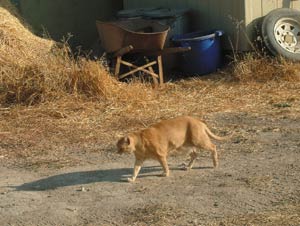Don’t call them
”
crazy cat ladies.
”
Armed with success stories on
”
humane
”
ways to reduce the number of feral cats roaming county land,
roughly two dozen animal rights advocates mobilized Tuesday to
defeat a policy they consider a death sentence for their feline
friends.
San Jose – Don’t call them “crazy cat ladies.”
Armed with success stories on “humane” ways to reduce the number of feral cats roaming county land, roughly two dozen animal rights advocates mobilized Tuesday to defeat a policy they consider a death sentence for their feline friends.
They failed, however, to convince Santa Clara County supervisors that the time has come for a “state of the art answer to the national crisis of feral cat overpopulation” (in the words of one advocate).
The method known as trap-neuter-release, or TNR, is “being used all over the world” to reduce feral cat populations, supervisors learned Tuesday from Rosi Mirko, the founder of Town Cats, a Morgan Hill nonprofit group that helps find homes for stray and feral cats.
She told supervisors that courses are offered on the proper feeding and care of animals under TNR, an approach that Mirko and other advocates see as a more humane alternative to the county’s current practice of sending feral cats to shelters, where they are euthanized if deemed unadoptable.
“It’s not a bunch of crazy cat ladies running out and feeding the cats,” Mirko said. “We do want to work with animal control. We are serious, and we want to reduce the cat population.”
Supervisors voted 3-2 (with McHugh and District 4 Supervisor Ken Yeager dissenting) to leave current practices in place, without codifying it into law. Supervisors did not address calls by advocates to work on a long-term effort to craft a TNR policy acceptable to county staff and animal rights groups.
Mirko and others decried a policy proposal that would have codified the county’s current practice of capturing feral cats based on complaints, and sending them to shelters where their temperaments and health are assessed.
The policy proposed by District 3 Supervisor Pete McHugh, himself a cat lover who has neutered nine cats in a backyard colony he maintains, would have called for greater efforts by staff at county shelters to find homes for cats. But even after dubbing it a first step on the way to a TNR policy, McHugh called his proposal a “half-hearted, partial measure.”
He originally endorsed a TNR policy released by the county’s Animal Advisory Commission in April, but took that policy off the table after opposition emerged among county staff and fellow supervisors.
“The TNR policy is not the central core of the issue. It’s whether or not cats should or can be maintained on county property under any circumstances,” County Executive Pete Kutras said to supervisors, emphasizing concerns about threats to other wildlife, disease and liability from scratches and bites.
Feral cats kill many native species of birds and reptiles, and conservationists note that feral cats are not native and instead prey on many native species of animals.
County officials facing a $227-million budget deficit have also said they do not have the funds to manage cat colonies on public property, though animal rights advocates say that volunteers have – and would – cover the costs of food, inoculations and other expenses.
An estimated 100,000 stray and feral cats are currently on county land, according to figures from the Animal Advisory Commission. The only sanctioned colony on county-owned land is at Elmwood Jail, where inmates and wardens have worked with animal caregivers to reduce the population from 120 to 20 cats in the last decade, according to animal advocates.
While advocates touted numerous other local success stories of the TNR approach, the scientific community does not seem to have settled on the matter.
The American Veterinary Medical Association has not formally endorsed or rejected the TNR approach, and has published studies demonstrating cases where the approach has both failed and succeeded. The association’s press office did not return a call for comment by press time.
Cats were not the only animals with supporters Tuesday. Bob Power, the executive director of the Santa Clara Valley Audubon Society, called for the county to find a humane way to work with cats “that falls short” of releasing them back into the wild.
“Feral and abandoned cats, even when well-fed, maintain their hunting instincts,” Power said, “and pose a threat to bird species.”








